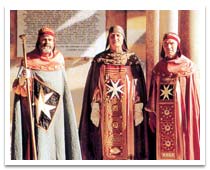With the death of Sicardo the hereditary princes had harsh
arguments and the Duchy was divided between Salerno, Benevento and Capua.
The election of Siconolfo, lord of Salerno, supported by Amalfi, persuaded
him to free the prisoners and give back their property and possessions…
This sad experience convinced the towns between Cetara and Positano to
unite: in December 839 , the free Republic of Amalfi was born…
Independent from 839 to 1137, the Republic of Amalfi was united under the “shield of silver, banded with red” an ample territory that spread from Lettere, Stabia, Tramonti and Chiunzi on the inland side, and from Cetara to Positano on the coast, with the island of Capri and the adjacent seas, identifying as inhabitants of Amalfi all the people who resided within these boundaries.
 |
Although united in political and military matters, every “Universitas”(City)
kept its name and autonomy of administration, but each performed a specific
service within the union.
Therefore as well as upholding the autonomy of productive and commercial
activities: Amalfi also was the seat of the Arch-diocese and of the central
government, at the vertices of which there were Prefects, Comities, Judges,
until in 954 Mastalo installed a hereditary Duchy; Atrani, Amalfi, the
only other “civis”(city) in the territory was the residence
of the Nobility of the city and the Church of S. Salvatore de Birecto
was the place of investiture of the Dukes; Minori’ s productive
and commercial centre was seat of the supplementary Arsenal, of the Bishops
palace and privileged home of many Dukes; Maiori the commercial heart
of the Duchy was seat of the Major Arsenal, the Admiralty, the Customs
and the salt warehouse; Scala was home of the most ancient and noble families
of the Duchy and had an acropolis and its own bishops palace; Ravello
a rich commercial centre ( it had a large fleet in the Eastern parts of
the Duchy) and was home of many noble families who took no part in the
government of the community, the opposition as we would call them today,
to end the list, Conca dei Marini and Praiano commercial centres with
well furnished fleets, wharfs and landing places; Positano was also a
rich commercial centre , seat of the Nautical School…